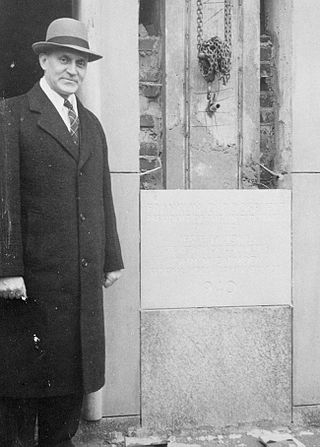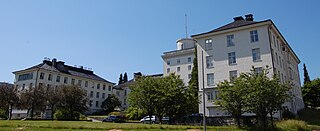Related Research Articles

A meteorologist is a scientist who studies and works in the field of meteorology aiming to understand or predict Earth's atmospheric phenomena including the weather. Those who study meteorological phenomena are meteorologists in research, while those using mathematical models and knowledge to prepare daily weather forecasts are called weather forecasters or operational meteorologists.
The Carl-Gustaf Rossby Research Medal is the highest award for atmospheric science of the American Meteorological Society. It is presented to individual scientists, who receive a medal. Named in honor of meteorology and oceanography pioneer Carl-Gustaf Rossby, who was also its second (1953) recipient.

Carl-Gustaf Arvid Rossby was a Swedish-born American meteorologist who first explained the large-scale motions of the atmosphere in terms of fluid mechanics. He identified and characterized both the jet stream and the long waves in the westerlies that were later named Rossby waves.

Vilhelm Friman Koren Bjerknes was a Norwegian physicist and meteorologist who did much to found the modern practice of weather forecasting. He formulated the primitive equations that are still in use in numerical weather prediction and climate modeling, and he developed the so-called Bergen School of Meteorology, which was successful in advancing weather prediction and meteorology in the early 20th century.

Jacob Aall Bonnevie Bjerknes was a meteorologist. He is known for his key paper in which he pointed the dynamics of the polar front, mechanism for north-south heat transport and for which he was also awarded a doctorate from the University of Oslo.

Erik Herbert Palmén was a Finnish meteorologist, born in Vaasa. He worked at the University of Chicago in the Chicago school of meteorology on cyclones and weather fronts with Vilhelm Bjerknes. He contributed to the explanation of the dynamics of the jet stream and the analysis of data collected by radiosondes; his preprocessed and quality checked datasets were widely used by other researchers. Palmen was a multisided researcher who published articles in meteorology, geophysics and oceanography. The 1969 book by Palmen and Chester W. Newton, "Atmospheric Circulation Systems: Their Structure and Interpretation", is still used as lecture material in the universities around the world.

Joseph Smagorinsky was an American meteorologist and the first director of the National Oceanic and Atmospheric Administration (NOAA)'s Geophysical Fluid Dynamics Laboratory (GFDL).

The Norwegian Meteorological Institute, also known internationally as MET Norway, is Norway's national meteorological institute. It provides weather forecasts for civilian and military uses and conducts research in meteorology, oceanography and climatology. It is headquartered in Oslo and has offices and stations in other cities and places. It has around 500 full-time staff and was founded in 1866.
Arnt Eliassen was a Norwegian meteorologist who was a pioneer in the use of numerical analysis and computers for weather forecasting.

Francis Wilton Reichelderfer, also known as “Reich”, presided over a revolutionary era in the history of the Weather Bureau. He trained as a U.S. Navy pilot and from 1922 -1928, was appointed Chief of Navy Aerology because of his meteorological and aviation experience. In 1931, he was assigned to the Bergen School of Meteorology. From 1938 to 1963, Reich directed the Weather Bureau and brought modern technology to weather forecasting.

Carl Anton Bjerknes was a Norwegian mathematician and physicist. Bjerknes' earlier work was in pure mathematics, but he is principally known for his studies in hydrodynamics.
Jørgen Holmboe was a Norwegian-American meteorologist.

The Geophysical Institute, University of Bergen is a marine research facility located in Bergen, Norway. Founded in 1917 by Bjørn Helland-Hansen, the institute studies the field of oceanography dealing with the patterns of the weather in the North Atlantic Ocean off the coast of Norway. Within recent years, focus has been increasingly on geophysics and environmental research. The research activities at the institute span from small scale measurement of turbulence up to studies of the large scale ocean currents, from local air and noise pollution up to studies of global scale climate change.

Eugenia Enriqueta Kalnay is an Argentine meteorologist and a Distinguished University Professor of Atmospheric and Oceanic Science, which is part of the University of Maryland College of Computer, Mathematical, and Natural Sciences at the University of Maryland, College Park in the United States.

The history of numerical weather prediction considers how current weather conditions as input into mathematical models of the atmosphere and oceans to predict the weather and future sea state has changed over the years. Though first attempted manually in the 1920s, it was not until the advent of the computer and computer simulation that computation time was reduced to less than the forecast period itself. ENIAC was used to create the first forecasts via computer in 1950, and over the years more powerful computers have been used to increase the size of initial datasets as well as include more complicated versions of the equations of motion. The development of global forecasting models led to the first climate models. The development of limited area (regional) models facilitated advances in forecasting the tracks of tropical cyclone as well as air quality in the 1970s and 1980s.
Ragnar Fjørtoft was an internationally recognized Norwegian meteorologist. He was part of a Princeton, New Jersey team that in 1950 performed the first successful numerical weather prediction using the ENIAC electronic computer. He was also a professor of meteorology at the University of Copenhagen and director of the Norwegian Meteorological Institute.
The Bjerknes Centre for Climate Research is a climate research centre in Bergen, Norway. The centres key areas of research is natural variability in the Earth system and man-made climate change. The centre combines observations with theoretical and modelling studies of past, present and future climates. Both Global and Polar regions are studied.
Erik Anton Björkdal was a Swedish meteorologist who studied at the Bergen School of Meteorology where the theory of fronts was developed. His contribution was mainly in the field of dynamic meteorology. Among his works, mention must be made of the correlation between the tropopause geopotential and the troposphere temperature.
The Vilhelm Bjerknes Medal is an award presented by the European Geosciences Union that recognizes "distinguished research in atmospheric sciences". It was first awarded in 1997, to Brian Hoskins, and later recipients include the Nobel-Prize-winning oceanographer and climate scientist Klaus Hasselmann. The award is named for Norwegian pioneer of weather forecasting Vilhelm Bjerknes, whose likeness features on the medal itself, designed by sculptor József Kótai.
References
- ↑ Harper, Kristine (2008). Weather by numbers: The genesis of modern meteorology. Cambridge, MA: The MIT Press.
- ↑ Nebeker, F. (1995). Calculating the weather: Meteorology in the 20th century. San Diego, CA: Academic Press, Inc.
- ↑ Kristiansen, T. A. (2017). Meteorologi på reise: Veivalg og impulser i Arnt Eliassen og Ragnar Fjørtofts forskerkarrierer [Meteorology on travel: Crossroads and impulses in the research careers of Arnt Eliassen and Ragnar Fjørtoft]. Unpublished doctoral dissertation, University of Bergen.